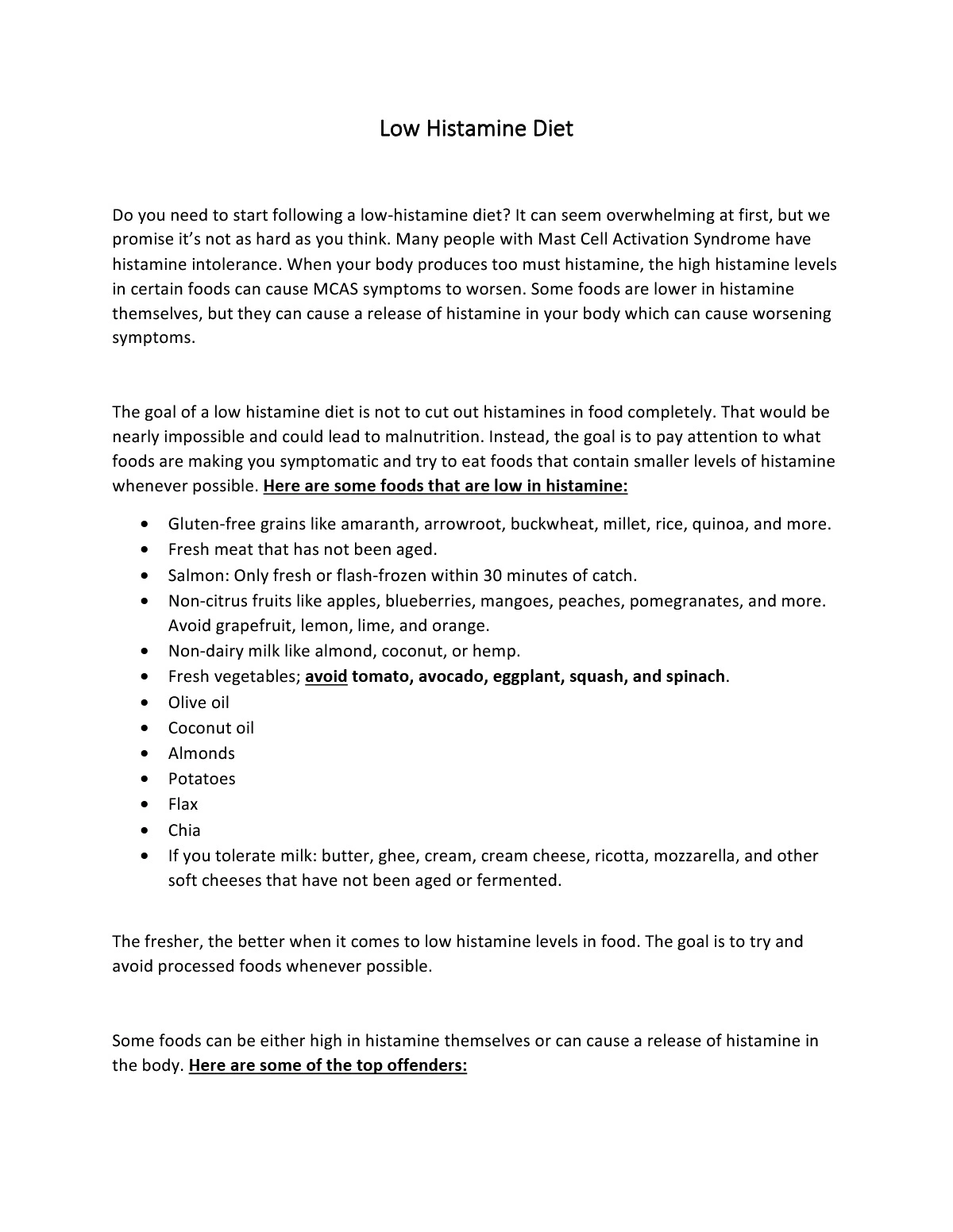
Low Histamine Food List Printable
Histamine intolerance is a non-immune reaction in which histamine accumulates in the blood due to a deficiency of diamine oxidase (DAO), the enzyme that plays the primary role in the metabolism of exogenous histamine.
Here are some foods that are low in histamine:Non-citrus fruits like apples, blueberries, mangoes, peaches, pomegranates, and more. Avoid grapefruit, lemon, lime, and orange. Non-dairy milk like almond, coconut, or hemp.
Top Histamine Food List
Here are some general pointers:
- Avoid or reduce eating canned foods and ready meals
- Avoid or reduce eating ripened and fermented foods (older cheeses, alcoholic drinks, products containing yeast, stale fish)
- Histamine levels in foods vary, depending on how ripe, matured or hygienic the foods are
- As much as it is possible, only buy and eat fresh products
- Don’t allow foods to linger outside the refrigerator – especially meat products
- Ensure that your food preparation area (kitchen) is always kept clean – but don’t be manic!
- Everyone has their own threshold; you will need to find yours
- Consult a certified dietician about working out a balanced diet
- Learn to cook! It can be loads of fun once you get into it
Foods that have been reported to have lower histamine levels and are thus to be preferred:
- Fresh meat (cooled, frozen or fresh)
- Certain fresh/frozen fish – hake, trout, plaice
- Chicken (cooled, frozen or fresh)
- Egg
- Fresh fruits – with the exception of plantains, most fresh fruits are considered to have a low histamine level (also see histamine liberators below)
- Fresh vegetables – with the exception of tomatoes, eggplant and spinach
- Grains – also products thereof such as rice noodles, white bread, rye bread, rice crisp bread, oats, puffed rice crackers, millet flour, pasta
- Fresh pasteurised milk and milk products
- Milk substitutes – goat milk, sheep milk
- Cream cheese, mozzarella, butter, (without the histamine generating rancidity)
- Most cooking oils – check suitability before use
- Most leafy herbs – check suitability before use
- Most fruit juices without citrus fruits
- Herbal teas – with the exception of those listed below
Foods that have been reported to have higher levels of histamine:
- Alcohol
- Eggplant
- Pickled or canned foods – sauerkrauts
- Matured cheeses
- Smoked meat products – salami, ham, sausages….
- Shellfish
- Beans and pulses – chickpeas, soy flour
- Long-stored nuts – e.g peanuts, cashew nuts, almonds, pistachio
- Chocolates and other cocoa based products
- Seitan
- Rice vinegar
- Ready meals
- Salty snacks, sweets with preservatives and artificial colourings
Foods that have been reported to have released histamine (histamine releasers):
- Most citrus fruits – lemon, lime, oranges…
- Cocoa and chocolate
- Walnuts, peanuts
- Papaya, pineapples, plums, kiwi and bananas
- Legumes
- Tomatoes
- Wheat germ
- Most vinegars
- Additives – benzoate, sulphites, nitrites, glutamate, food dyes
Foods that have been reported to block the diamine oxidase (DAO) enzyme:
- Alcohol
- Black tea
- Energy drinks
- Mate tea
Debatable:
- Yoghurt – depends on the bacteria culture used
- Egg white – The theory, that egg white is a histamine releaser has been dismissed.
Other:
- Yeast – even though it does not contain histamine as such, yeast serves as a catalyst for minor or major histamine generation during leavening depending on product. There is no yeast in the end product. Relevance of yeast for HIT-patients is under discussion.
- Yeast extract has been reported to be very high in biogenic amines and a DAO inhibitor and is therefore deemed not suitable in the low-histamine diet.